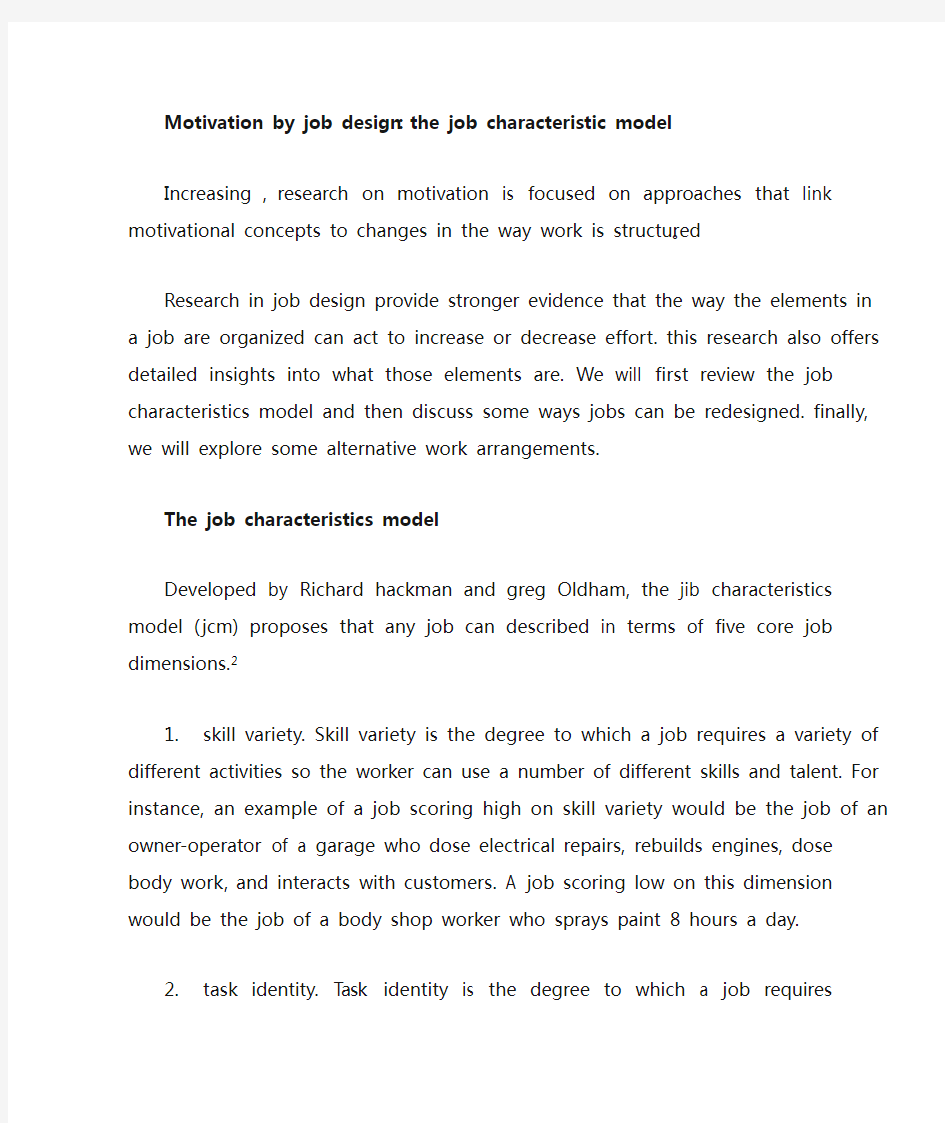The job characteristics model


Motivation by job design:the job characteristic model
Increasing,research on motivation is focused on approaches that link motivational concepts to changes in the way work is structured。
Research in job design provide stronger evidence that the way the elements in a job are organized can act to increase or decrease effort. this research also offers detailed insights into what those elements are. We will first review the job characteristics model and then discuss some ways jobs can be redesigned. finally, we will explore some alternative work arrangements.
The job characteristics model
Developed by Richard hackman and greg Oldham, the jib characteristics model (jcm) proposes that any job can described in terms of five core job dimensions.2
1.skill variety. Skill variety is the degree to which a job requires a variety of different
activities so the worker can use a number of different skills and talent. For instance,
an example of a job scoring high on skill variety would be the job of an
owner-operator of a garage who dose electrical repairs, rebuilds engines, dose body
work, and interacts with customers. A job scoring low on this dimension would be
the job of a body shop worker who sprays paint 8 hours a day.
2.task identity. Task identity is the degree to which a job requires completion of a
whole and identifiable piece of work. An example of a job scoring high on identity
would be the job of a cabinetmaker who designs a piece of furniture, selects the
wood, builds the object, and finishes it to perfection. A job scoring low on this
dimension would be the job of a worker in a furniture factory who operates a lathe
solely to make table legs.
3.task significance. Task significance is the degree to which a job has a substantial
impact on the lives or work of other people. An example of a job scoring high on
significance would be the job of a nurse handling the diverse needs of patients in a
hospital intensive care unit. A job scoring low on this dimension would be the job of
a janitor sweeping floors in a hospital.
4.autonomy. Autonomy is the degree to which a job provides substantial freedom,
independence, and discretion to the individual in scheduling the work and in
determining the procedures to be used in carrying it out. An example of a job scoring
high on autonomy is the job of a salesperson who schedules his or her own work
each day and decides on the most effective sales approach for each customer without
supervision. A job scoring low on this dimension would be the job of a salesperson
who is given a set of leads each day and is required to follow a standardized sales
script with each potential customer.
5.feedback. Feedback is the degree to which carrying out the work activities required
by a job results in the individual obtaining direct and clear information about the
effectiveness of his or her performance. An example of a job with high feedback is
the job of a factory worker who assembles ipods and tests them to see if they operate
properly. A job scoring low on feedback would be the job of a factory worker who,
after assembling an ipod, is to route it to a quality-control inspector who tests it for
proper operation and makes neeed adjustments.
The picture percents the job characteristics model. Note how the first three
dimensions-skill variety, task identity, and task significance-combine to create meaningful work.. that is, if these three characteristics exist in a job, the model predicts that the incumbent will view the job as being important, valuable, and worthwhile. Note, too, that jobs with high autonomy give job incumbents a feeling, employees will know how effectively they are performing. from a motivational standpoint, the JCM says that individuals obtain internal rewards when they learn (knowledge of results) that they personally (experienced responsibility) have performed well on a task that they care about (experienced meaningfulness).3the more these three psychological states are present, the greater will be employees’motivation, performance, and satisfaction and the lower their absenteeism and likelihood of leaving the organization.
As the picture shows, the links between the job dimensions and the outcomes are moderated or adjusted by the strength of the individual’s growth need-that is, by the employee’s desire for self-esteem and self-actualization. This means that individuals with a high growth need are more likely to experience the psychological states when their jobs are enriched than are their counterparts with low growth need. Moreover, the individuals with a high growth need will respond more positively to the psychological states when they are present than will individuals with a low growth need.
The core dimensions can be combined into a single predictive index, called the motivating potential score (MPS), which is calculated as follows:
MPS = (skill variety + task identity + task significance)÷3×autonomy×feedback
Jobs that are high on motivating potential must be high on at least one of the three factors that lead to experienced meaningfulness, and they must be high on both autonomy and feedback. If jobs score high on motivating potential, the model predicts that motivation, performance, and satisfaction will be positively affected and that the likelihood of absence and turnover will be reduced.
Endnotes
2.J. R. Hackman and G. R. Oldham, "Motivation Through the Design of Work: Test of a Theory," Organizational Behaviour and Human Performance, August 1976, pp. 250-279; and J. R. Hackman and G. R. Oldham, Work Design (Reading, MA: Addison-Weley, 1980).
3.J. R. Hackman, "Work Design," in J. R. Hackman and J. L. Suttle (eds.), Improving Life at Work (Santa Monica, CA:Goodyear, 1977), pp. 129.
